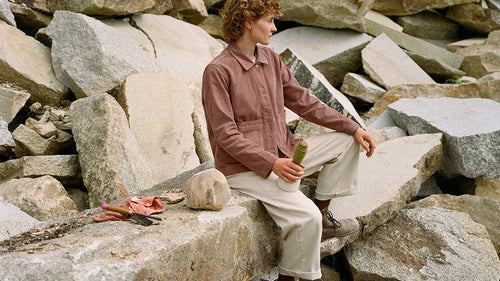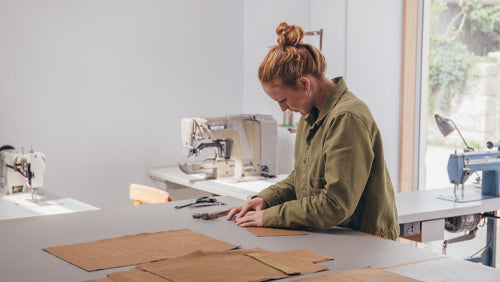An original piece by Alec Leach commissioned by Paynter.
Contemporary consumerism is a cycle of hauls and purges. We pile up spontaneous purchases, amassing pieces that don’t do or mean much for us, and then we get rid of them, flogging them on resell apps or dumping them at the local charity shop (as if they weren’t overflowing with clothes already). You don’t need to have a degree in sustainability to know that this is terrible for the planet, but it’s hard to argue that it’s good for us as people, either — all those trends might seem really important at the time, but ultimately they’re meaningless.
Really, compulsive shopping is like fast food — it might be fun for a moment, but once the high wears off, you’re left with regret. It’s not long before the latest hyped-up whatever becomes an embarrassment and you have to get rid of it, starting the whole process again. It’s a dissatisfying cycle, but it doesn’t have to be that way. If you’re doing it with intention, shopping can be about investing, rather than desperately keeping up with what’s new.

Since I left my old job as a fashion editor, I’ve been figuring out how to take control over my shopping habits, to get good at shopping. In my mind, one of the most important ways of reducing our environmental footprint as consumers is to get better at shopping, to make way for less regretful purchases and more intentional ones. But how do you do that, exactly?
You need to shift your perspective. You need to think about style in a timeless way, so that you’ll always feel great in your clothes. It’s about considering wearability, so you can come back to your favourite pieces again and again. Finally, you should consider quality, so that the great clothes you buy stay great for years to come.
I know that the best purchases I’ve made are things that have all three of those qualities (Becky & Huw at Paynter take them very seriously, too). My first ever leather jacket, my favourite black boots, old band tees and perfect suits I found on eBay — they’re all things that I’ve had in my life for years, and I love wearing them in all kinds of situations. They’re the exact opposite of regret purchases: pieces that bring me joy every time I pull them out of my wardrobe.
More philosophically, shopping more mindfully is a journey of figuring out what works for you, and what doesn’t. I know I’ll always feel good in a leather blazer, while anything slim-fit is a no-go. Some things might suit me, like knitted polo shirts, but I’d still rather admire them from afar.

Shopping this way might not come naturally, especially if you grew up in an era where clothes are viewed as disposable indulgences rather than objects to own, but it’s worth it in the long run. Once you get used to the idea of shopping with intention, you can make regret purchases a thing of the past.
Buying slower means buying less, which is better for the planet, too. Here’s the thing about sustainability: fashion’s biggest source of pollution and carbon emissions comes from making new clothing, so buying less of them is the biggest way of reducing the impact of your shopping habits, rather than stockpiling quote-unquote sustainable products. It’s also an opportunity to support businesses that reflect your values, instead of giving your money to corporations trashing the planet and the people living on it.
It’s a slower way of engaging with fashion, where shopping becomes a purposeful search for things that make you feel great instead of getting dragged into a never-ending hamster wheel of trends and fads.
Here’s some examples of really intentional, purposeful purchases that some members of Paynter’s extended family have made over the years. What so many of these stories have in common is quality, timeless style, and wearability — key things to bear in mind when shopping in a slower, more mindful way.
 “One of my favourite pieces of clothing is a humble cotton seersucker shirt that belonged to my grandma, ‘Gam’. It’s comfortable, classic and versatile - I can throw it on over a swimsuit at the beach, wear it with shorts, jeans or comfy trousers, have it open or buttoned up. If I wanted to sleep in it, that would be fine too. It embodies every quality I want in my clothing, with the added bonus of feeling like a hug from someone I love.”
“One of my favourite pieces of clothing is a humble cotton seersucker shirt that belonged to my grandma, ‘Gam’. It’s comfortable, classic and versatile - I can throw it on over a swimsuit at the beach, wear it with shorts, jeans or comfy trousers, have it open or buttoned up. If I wanted to sleep in it, that would be fine too. It embodies every quality I want in my clothing, with the added bonus of feeling like a hug from someone I love.”
Hannah Cousins, Artist

“Undoubtedly my favourite item of clothing is the bespoke red blazer that I commissioned from the Japanese master of Ivy League, Tailor Caid. The idea originally came from the cover for the Dexy Midnight Runners album “Don’t Stand Me Down — The Director’s Cut”. I wanted (needed), brass buttons, patch and flap pockets, a centre vent, thick welted seams and a sack cut, with an easy breezy fit. I came to fully appreciate it when I took it on holiday to Stockholm and Copenhagen in 2019 and I ended up wearing it everyday. Somehow it went perfectly with everything else that I packed, looking just as good over a plaid flannel shirt and jeans as with a blue oxford and grey flannels.”
Dick Carroll, Cartoonist
 “When something feels just right, I’ll wear it for decades. I have a handful of pieces that feel like this, and try not to buy much otherwise. One example is a necklace I found in Portobello when I was 15, made of old Indian coins. It wasn’t expensive and I didn’t know why I liked it, it wasn’t particularly trendy, but for the first 5-7 years of owning that necklace I easily wore it 350 of 365 days every year. I still wear it every week. It’s threaded on a thick black cotton cord which has disintegrated again and again, but it’s easy to mend and I still remember the day I bought it, nearly 15 years on. Other pieces that fit into this category are my Paynter Car Coat, the denim jackets we've made and an embroidered cuban shirt by Bode. The handiwork is a true work of art and when I finally bought it after plenty of time pondering and saving, I hung it in-front of my wardrobe rather than inside, so I could look at it whenever I wasn't wearing it.
“When something feels just right, I’ll wear it for decades. I have a handful of pieces that feel like this, and try not to buy much otherwise. One example is a necklace I found in Portobello when I was 15, made of old Indian coins. It wasn’t expensive and I didn’t know why I liked it, it wasn’t particularly trendy, but for the first 5-7 years of owning that necklace I easily wore it 350 of 365 days every year. I still wear it every week. It’s threaded on a thick black cotton cord which has disintegrated again and again, but it’s easy to mend and I still remember the day I bought it, nearly 15 years on. Other pieces that fit into this category are my Paynter Car Coat, the denim jackets we've made and an embroidered cuban shirt by Bode. The handiwork is a true work of art and when I finally bought it after plenty of time pondering and saving, I hung it in-front of my wardrobe rather than inside, so I could look at it whenever I wasn't wearing it.
Becky Okell, Co-Founder, Paynter

"Of all the jackets we’ve made, this is the one I wear the most. And honestly, the one I'm most proud of. It’s not just the fabric, the small details, the giant inside pockets or the references it’s built on. It’s the feeling it gives me when I put it on.
I can’t quite put my finger on it. Maybe it's because I wanted to be a cowboy growing up. Maybe it’s because I have a deep blue love for denim. Maybe because it reminds me of the great time we had on the photoshoot with close friends.
I just can’t quite put my finger on it. What I do know, whenever I put this jacket on, I feel like me."
Huw Thomas, Co-Founder, Paynter
Alec Leach is an author and strategist working in sustainability. His debut book, “The World Is On Fire But We’re Still Buying Shoes”, is out now.
Illustrations by Dick Carroll for Paynter.




